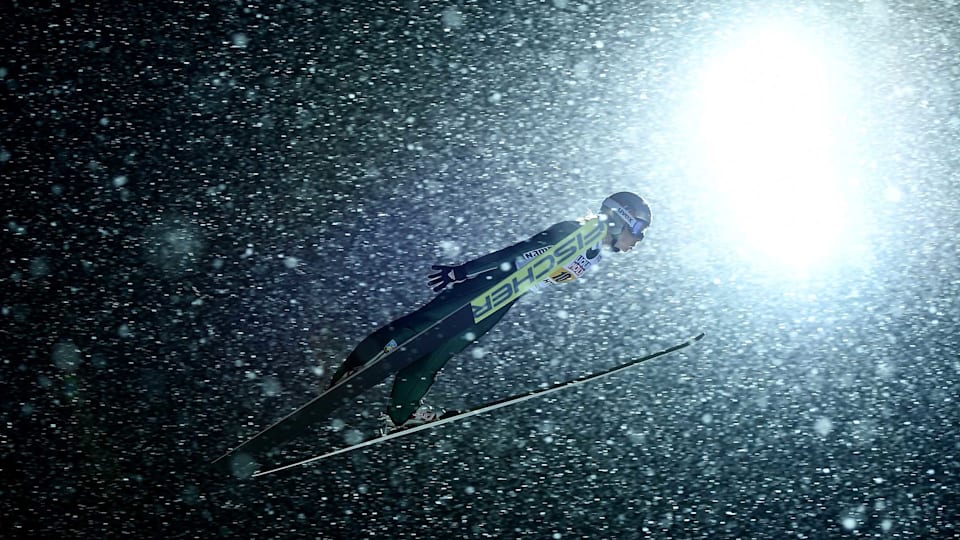Maren Lundby’s Guide to Ski Jumping at PyeongChang 2018
Maren Lundby has thrown herself off high ramps on skis since she was three years old. Here, ski jumping’s shooting star reveals how she jumps more than 100 metres at 90kmh as she aims for new heights at the Olympic Winter Games PyeongChang 2018.

Arguably winter sport’s most iconic event, in which athletes glide down a steep ramp before launching and landing over 100 metres away, ski jumping originates from Norway, where the discipline’s first competitions were held in the 19th century. An Olympic event since 1924, the sport has come a long way since Norwegian-Danish Ole Rye landed at 9.5m in the first recorded jump in 1808.
“It is indescribable. You feel that there is so much power and pressure involved, it’s a real adrenaline rush to experience,” said Maren Lundby, Norway’s top female jumper. “You feel like you break the law of gravity in a way. If you hit the right angle with the skis, then you just fly out from the hill.”
Lundby was only three years old when she jumped off a ramp on skis for the first time.
“My older brother was ski jumping, so I tried it at a young age and I’ve been doing it since. I started with a small ramp and then it became bigger and bigger – and here we are,” the 23-year-old said.
However, “the flower of ski sports”, as ski jumping is known, is not just about flying as far as possible. The jumpers are also scored by five judges on landing, style and weather conditions, and the athlete with the most points after two rounds wins.
Key skills & top tips
Lundby has enjoyed a breakthrough season, winning six of the first eight World Cup competitions, finishing second in the other two and topping the overall ranking.
“I had thought I’d be fighting in the top, but this has exceeded all expectations,” she said.
“Earlier I’ve been a bit too unstable to stay in the top, but this year I’ve been much more stable and have much more control over the technique.”
Before the leap, a ski jumper glides down the inrun – the ramp angled at between 35 and 37 degrees – in a squat position, reaching speeds of around 90kmh. Lundby thinks her improved balance in the take-off has been key to her recent stellar results.
It is indescribable. You feel that there is so much power and pressure involved, it’s a real adrenaline rush to experience Maren Lundby - Maren Lundby
“The most important moment for me is to have a good balance in my upper body when I’m in the squatting position, just before I jump. You want to keep that position for as long as possible to get maximal vertical power,” she said.
“From there you just need to use the aerodynamics to fly far. That is decided from the balance in the inrun and take-off – if things go well there, a lot of the work is done.”
In flight, the wider you can make yourself, the further you go, according to Lundby. That is why Swedish ski jumper Jan Boklov revolutionised the sport in the 1980s with the v-shaped jumping style widely used today.
“You have to manage to kind of stay above the air, so that you don’t stop but rather glide on top of the air, aiming to get as many square centimetres as possible to fly on, making oneself as wide as possible with the arms and skis. You have flat skis so that you can fly on as much of their surface as possible,” Lundby said.
The Norwegian’s preparations for the Olympic Winter Games PyeongChang 2018 include a lot of leg training. Trying to lose weight to fly further is not an option.
“We’ve got rules saying that you can’t be under a certain weight in relation to your height,” Lundby said.
“If you are, you have to jump with shorter skis, which gives you a disadvantage as there’s less to fly on. Of course it helps being light, but there comes a point where it doesn’t any more.”
Jumping for gold
Fighting for PyeongChang medals with women’s ski jumping’s first Olympic champion, Sochi 2014 gold medallist Carina Vogt (GER), as well as four-time World Cup overall winner Sara Takanashi (JPN) and Katharina Althaus (GER), who grabbed two World Cup wins from her this season, Lundby refuses to let this year’s success add any weight to her shoulders in Korea.
“I just think about this as something positive,” she said. “It’s a sign that I’m in good shape. Confidence is important in ski jumping, so I feel that it’s an advantage rather than pressure,” she said.
What she aims for as she throws herself from the ramp in PyeongChang is more than the so-called K-Point – the red line marking a certain distance from the take-off.
“I said before the season that an Olympic gold is the goal, and I still stand by that.”
